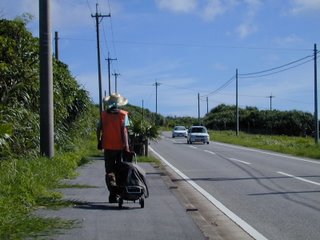Saturday, December 06, 2014
Monday, December 26, 2011
Japan on Foot book Now Published

My book Japan on Foot has finally come off the presses. Published by FineLine Press in New Zealand, the book tells of my 7,500-km "roving reporter" walk through Japan. I uncover aspects of Japan that are rarely, if ever, talked about.
You'll find culture, history, myths and legends, as well as enjoy reading the adventures and rigours of walking 15 months around Japan's five main islands and some of its smaller ones. Meanwhile, on this blog you can read some of the stories I wrote for Look Japan magazine and website while out walking the roads of Japan, but do know that the book is a far different (and better) beast than this blog.
Some of the people you will meet in the book include the indigenous Ainu, the Buraku people (long considered outcasts in Japan), bear hunters, farmers, Buddhist monks, pilgrims, shamens and yakuza. You'll learn about the so-called tombs of Moses and Jesus in Japan, the world's oldest dolls, Living Buddhas, haunted houses, UFOs, love hotels and meet a scientist who is planning to resurrect the woolly mammoth and a geologist who claims that off the shores of Okinawa lies the ruins of a lost civilization.
Order the book Japan on Foot NOW!
If you are in Tokyo in mid-May come and join me at one of the book launch parties.
Sunday, October 10, 2010
Forty Stories of Japan Book Launch Party

Nov. 3 will be the book launch party for Forty Stories of Japan.
Sunday, August 29, 2010
New Publisher To Work With
Two other publishers have expressed interest, but the one I am
likely go with is Fineline Press in New Zealand.
In fact, Fineline Press has already published one Japan on Foot
story in the book Forty Stories Of Japan.
I have to do some rewriting, but once that is done I am confident
that the book will finally be published. Have to say that getting
the book published has proved to be far more arduous than
the walk :-)
Sunday, July 16, 2006
Part 7: OKINAWAN ISLAND HOP
***
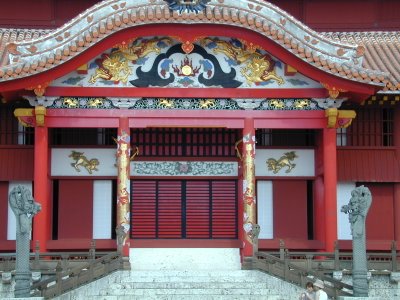
Far From Disney
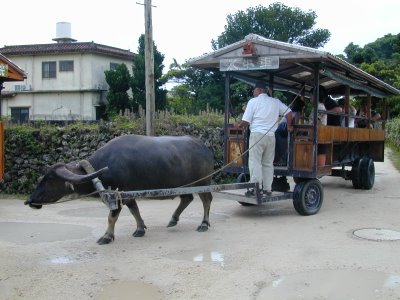
ALL PHOTOS BY JAPAN ON FOOT 2001/2002
FROM ISHIGAKI Island, we hopped on a crowded speedboat that leaped across an angry sea as we headed into the eye of a storm. My whole body stiffened with fright and I broke out in a cold sweat as I frantically looked around for life jackets, only to discover there were none. Etsuko’s senses were dulled after taking the motion-sickness tablets. She was in a zombie-like, bleary-eyed state of half-sleep while I, in a state of terror, clutched onto the seat in front of me. My arms trembled as I peered out at the two-metre-high waves that tore at the Anei. I feared that at any moment we would capsize. I hadn’t been gripped by such fear since a river-rafting expedition several years earlier. During the day’s venture on the Zambezi River, renowned as the roughest river in the world, the raft had capsized three times on the volatile rapids. With each dipping, I became more resigned to the fact that I would probably not live to see the end of the day. The rapids had sucked me down time and time again, churning me in their bowels of water as if I were some rag flung in a washing machine. It had been an agonizing experience to realize that it was impossible to swim, and that the more I tried to, the more I was sucked down into the hungry mouths of the rapids and left spluttering on mouthfuls of water and gasping for air the moment I was tossed back to the waters’ surface. My whole life had flickered before my eyes. I was completely helpless; I couldn’t even save myself, let alone try and help Etsuko who, at that time, couldn’t swim a stroke. Two tourists had died on the river just a month earlier; an elderly man had a heart attack when his raft capsized on a rapid and, on another Zambezi expedition, a young English woman had drowned. Apparently, her shoelace had got caught around the branches of a huge tree on the river’s bottom. Parts of her body were found a few days later, much further downstream.
"The crocodiles had eaten most of her," our African guide had told us before Etsuko and I had joined up with a group of fellow backpackers and signed up for the river adventure. But, after the near-drowning experience on the Zambezi, I swore I would never participate in any water sport again. Etsuko, however, surprised me by saying that she would love to do it all over again. I was deeply impressed by the fact that she had not let her near-death experience dampen her enthusiasm for rafting.
"I just kept wondering when I would ever come up above water, that it was taking such a long time to float up to the surface and that I couldn’t see the raft or anybody else. I felt quite calm and curious about the predicament; that I was going to die because I reached a point where I could no longer breathe, and then, finally, I was spluttering with my head above water," she calmly told me after the incident.
I had gone into spasms on hearing that Etsuko had not kicked one foot or pushed herself upwards with her arms in order to reach the river’s surface sooner. It was something that I presumed would be a natural human reflex reaction when drowning. On return to Japan, Etsuko succumbed to my nagging and took swimming lessons. She turned out to be a much stronger swimmer than I am, but as I peered out of the window of the Anei, I knew that there would be no hope for any of us if the vessel capsized out in this raging sea. The small vessel was hurled higher and higher on the tails of waves and would then come crashing down with an almighty thump that threw passengers and crew from their seats. Etsuko had resigned herself to fate.
"There’s nothing that can be done," she sleepily slurred.
She was right, of course. I only wished that I could be more accepting of death and face it with such calmness. Instead, I found myself becoming irritated by a group of young men who whooped and cheered every time our vessel was thrown into the air or made a precarious crash-landing. Couldn’t they appreciate the potential danger? Why were they behaving like we were on some roller coaster at Disney? The crew was tense; fear was written plainly across the three men’s faces. Perhaps they regretted not canceling the voyage, I mused. The ticket sellers had told us that probably all sea crossings would be cancelled.
"The weather’s not looking so good. A typhoon is on the way. I doubt anyone will be leaving today for Hateruma," a middle-aged woman had warned us just a few hours before.
Then, at the last minute, we were told tickets were being sold; the boat would leave for Hateruma after all. Passengers and crew eventually staggered off the Anei, out onto dry land. As soon as my feet touched the asphalt, I threw up. The thought of another sea voyage the following day made me shudder. We had quite a few more sea voyages yet to make before reaching Yonaguni-jima island. The same stretch of water would take us back to Ishigaki Island, from where another vessel would spirit us to nearby Taketomi Island. And, from Taketomi Island we would need to return yet again to Ishigaki Island in order to board the ship that would take us even further out to sea, to our ultimate destination.
"We can always fly, if you want," Etsuko offered, seeing that I was badly shaken, but I didn’t want to succumb so easily to my fears. After all, we had initially agreed that Japan on Foot was a walk.
"To fly would spoil the spirit of our walk. I just can’t wimp out like that, not now; we’re so near to reaching Yonaguni," I said. We trotted on past fields of towering sugar cane, palms and banana trees where goats snuffled around for food. Finally, we found what we had come looking for: the rock boulder that marks Japan's southernmost inhabited point.
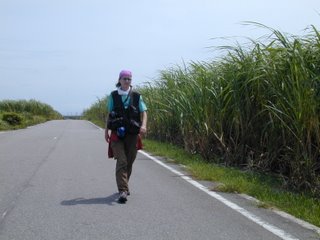

ALL PHOTOS BY JAPAN ON FOOT 2001/2002
AFTER A ten-minute boat trip from Ishigaki Island, Etsuko and I alighted on yet another Okinawan Shangri-la—Taketomi Island. We spent two nights on this isle of about 270 souls. With a circumference of less than ten kilometes, it takes less than three hours to stroll round it, but Etsuko and I decided not to circumnavigate the island. Instead, we were happy just to meander along its country lanes, admiring the shisa (lions-dogs) that adorn the gateposts and beautiful red-tiled roofs of the houses here. The shisa has long been believed to ward off evil spirits, but I really couldn’t imagine that anything more malevolent than poisonous snakes could haunt this island. Occasionally, a bull, pulling a cartload of tourists, would mosey on past us, giving a weary snort or throwing us an indifferent, bleary-eyed glance. Coral walls protect Taketomi Island’s homes from lashing typhoon winds, and gardens flow over with an abundance of tropical flora and fauna—bougainvillea and hibiscus flowers burst forth here and there, while banana trees, sugar cane and palms sway in the gentle sea breeze. Huge butterflies in kimono of blacks, deep reds and purple flitted constantly passed us.
Taketomi was truly idyllic, and we were only sad that our sojourn on this little paradise would be so short.

The walk had really come to an emotional ending for us once we arrived in Shuri City, on the Okinawa mainland. But now, as we realized that the next sea voyage would spirit us to Yonaguni Island, our destination goal, Etsuko and I were plagued by an incredible downer. We never doubted that we could cover such a great distance on foot, but the isle on which Etsuko’s mother and grandmother were born and raised, had for more than a year felt like a lifetime away. In some kind of way, neither of us ever wanted to reach the shores of Yonaguni Island and explore the underwater structure that lies off its shores that some claim to be the ruins of Mu—the Asian equivalent of Atlantis. From Ishigaki Island we sailed to our destination goal. It felt quite unreal when we finally stepped down the gang plank and onto the shores of Yonaguni Island. As soon as we did though we were drawn into festivities that were taking place, leaving little time for me to brood. Fishermen were sailing small boats into the port to unload their catches of billfish for the annual Billfishing Contest. Cranes were lifting up the carcasses of fish that weighed close to two-hundred kilograms. I had never seen a spectacle quite like it since my early days in Tokyo when I had made a trip down to Tsukiji Fish Market, reputed to be the world’s biggest fish market. Much laughter and cheering was going on as islanders took to a set-up stage to sing Okinawan folk songs and announce the weight of the latest big catch. 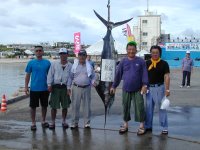 Etsuko and I grabbed a couple of beers and some fried squid at one of the nearby marquees and sat ourselves down to absorb the goings-on of the day, before signing up for a trip in a glass-bottomed boat that would take tourists out to view the Iseki Point, the underwater structure that had been found some years earlier by one of the island’s divers. Just a few weeks before, we had met with Dr. Masaaki Kimura , a geologist and a professor at the University of the Ryukyus, who maintains that the structure is partially man-made and that beyond this, it is a testament of a lost civilization, one that predates that of Egypt and all other known civilizations.
Etsuko and I grabbed a couple of beers and some fried squid at one of the nearby marquees and sat ourselves down to absorb the goings-on of the day, before signing up for a trip in a glass-bottomed boat that would take tourists out to view the Iseki Point, the underwater structure that had been found some years earlier by one of the island’s divers. Just a few weeks before, we had met with Dr. Masaaki Kimura , a geologist and a professor at the University of the Ryukyus, who maintains that the structure is partially man-made and that beyond this, it is a testament of a lost civilization, one that predates that of Egypt and all other known civilizations.
The End of the Road
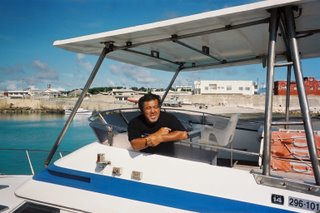
ALL PHOTOS BY JAPAN ON FOOT 2001/2002
IT WAS in 1986 that Kihachiro Aratake went diving off the shores of Yonaguni Island. He hoped to find a new spot to show tourist-divers hammerhead sharks. The native islander, however, discovered something far more exciting—a huge underwater structure that he could only imagine was an ancient ruin. Some of the island’s fishermen had talked of a structure that they occasionally caught a glimpse of when just one hundred metres off shore, but Mr. Aratake found himself exploring at close range something he couldn’t imagine to be true, and so he decided to keep it a secret.
“I was certain it was an ancient ruin. In all my years of diving, I had never seen anything quite like it. However, since it became known to the academic world many specialists, from Japan and overseas, have dived down to study it. Some believe it is partially man-made, others claim it is purely natural, but either way it is an incredible structure,” the fifty-five-year-old diver excitedly told us at his home on Yonaguni Island, while pulling out photographs and slides of the Yonaguni Submarine Pyramid for us to view. Etsuko and I had already viewed the structure from a glass-bottomed boat and were aware of how impressive it is, but Mr. Aratake’s photography had truly captured the magical essence of this mysterious underwater world that lies twenty-five metres under the ocean. Like all the other diving points on the island, Mr. Aratake named this one too. “I called it Iseki (Ruins) Point because it resembles the ruins of an old temple with a pyramidal structure. And, now the main diving attraction on Yonaguni is not hammerhead sharks; it’s Iseki Point, and my discovery of it has ended up making me quite famous,” laughed Mr. Aratake, who over the years has dived down with such people as the famed French diver Jacque Mayol, the radical U.S. geologist Robert Schoch, as well as Britain’s Graham Hancock, who has written several books on his investigations to prove that a lost civilization, one much older than Egypt’s, once existed. But could it be possible that Iseki Point is man-made? Is it possible that it could date back ten thousand years and attest to the existence of a yet unknown civilization, one that predates ancient Egypt? Some people argue that what lies under the ocean at Yonaguni Island is the remains of Mu, a lost civilization of mythical proportions, one that is Asia’s equivalent of Atlantis. However, one Japanese academic is adamant that Iseki Point is man-made. A geologist with more than thirty years experience, and a professor at the University of the Ryukyus on the main Okinawan island, Dr. Masaaki Kimura maintains that Iseki Point is man-made, probably ten thousand years old and serves as evidence of a civilization that he light-heartedly calls Ma.
“I don’t believe that Mu existed. I don’t believe that such a huge continent ever existed in the South Pacific, but I do believe that a huge continent existed in the West Pacific Ocean and that Okinawa was once part of that continent. I call this lost continent the West Pacific Paleo Lands, or Ma Land for short,” Dr. Kimura told Etsuko and me when we interviewed him prior to sailing out to the smaller Okinawan islands.

“Chinese mythology refers to an ancient civilization in the east called Horai, meaning paradise, or utopia. There is an ancient bell in a museum in Shuri City that has the word Horai engraved on it; you can also find similar bells, marked the same way, in Taiwan. Several ancient Chinese documents refer to Horai and its having been submerged under water. In Okinawa, you find the legend of Nirai Kanai, people who are coming from the bottom of the sea, and in Japan, the legend of Urashima Taro is well known but is a legend that can also be heard in India and Tibet,” continued Dr. Kimura, who has dived out to Iseki Point more than one hundred times since 1992. During these dives he takes rock and coral algae samples for geological testing, takes photographs and measures features that he maintains prove that the structure is man-made. He has also found tools on the seabed and rocks bearing carved symbols, as well as rock reliefs of various animals--from bird and turtles, to what appears to be a boar or cow. Dr. Kimura showed us slides and photographs of what he maintains are roads associated with drainage canals, as well as tool marks in the rock structure, flat terraces, straight walls, pyramidal steps and various other characteristics that he maintains prove that the structure is, beyond a shadow of a doubt, not simply a natural phenomenon.
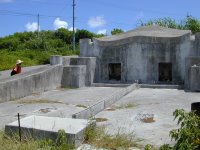
Stone tools and what Dr. Kimura says is a Moai-like rock-carving are among other items that tend to back up his theory. “Iseki Point seems to have been fabricated on land and then submerged underwater. Our surveys reveal that the overall shape and features of Iseki Point are greatly similar to gusuku (castles) in ancient Okinawa, and particularly show resemblance to Shuri and Nakagusuku castles (on Okinawa island), explained Dr. Kimura. “The gusuku has been thought to be something like a combination of a castle and a temple, and the remains of gusuku look like a sort of pyramid. The cliff steps at Iseki Point resemble a stepped pyramid, and dating tests I have conducted suggests that this structure is around ten thousand years old,” Dr. Kimura told us. The professor showed us slides of what he believes are rock carvings of a bird and turtles, as well as of the “Moai,” the canals, tool marks and the steps of what he has dubbed the Yonaguni Submarine Pyramid. Certainly, to the layman he presents striking evidence that what lies under water must indeed be manmade. But, although some geologists and archaeologists support his view, most insist that the structure is nothing more than a natural freak. Dr. Kimura is saddened by the thought that it is more likely that Western academics will be the first to seriously study the structure and verify his theory, rather than Japanese. “Japanese archaeologists are very conservative; they don’t like to work with things that they are not familiar with and especially if it involves work that could prove to be threatening to the status quo and shake-up agreed on archeological theories and history,” he said. Etsuko and I took a morning’s crash-course in diving, but unfortunately we didn’t have what it takes to make the plunge out to Iseki Point that same day with a group of skilled divers that had signed up with Mr. Aratake’s diving school. “Don’t worry, we have the clearest waters in the world here,” Mr. Aratake comforted us. “Just put these goggles on and hang off the edge of the boat while I pull you across Iseki Point,” he laughed. Huge waves lapped over us and we gagged on mouthfuls of water, but below us lay a marvelous, mythical world; one whose true mystery waits to be wholly unraveled. It was the most unforgettable experience, the topping on the cake of our long walk.
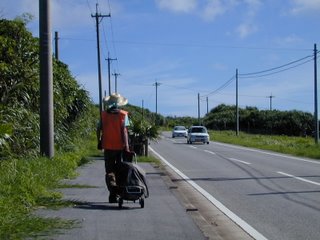
***
On August 15th, 2002, the Japan on Foot project officially ended on Yonaguni Island, Okinawa, with our snorkel out over Iseki Point, what some claim is the remains of the lost civilization of Mu. The project, which started May 9th, 2001, from Cape Soya, Hokkaido, involved Mary King and Shimabukuro Etsuko walking an actual distance of 7,494 kilometres.

Tuesday, May 16, 2006
No. 3: SHIKOKU ISLAND
SHIKOKU IS a walkers’ paradise, with most people coming here as pilgrims to follow the mandala-like circuit of the eighty-eight temples that are dedicated to the island’s famous son, Kobo Daishi. The ninth-century monk spent years wandering the mountains and forests of this island before reaching enlightenment in a cave on the island’s southeastern tip. Today, thousands of pilgrims follow in the footsteps of Kobo Daishi (a.k.a. Kukai), founder of the Shingon Buddhist sect, but how many people who visit the temples and shrines of Shikoku have heard that another great religious leader came here bearing the treasures of King Solomon, and that the Ark of the Covenant lies buried under a shrine in Tokushima prefecture? According to a former councilor of Kamiyama town, the Old Testament prophet Elijah came to Shikoku with members of an ancient Hebrew tribe, bearing the Ark of the Covenant, as well as such treasures as the Ten Commandments, Aaron’s rod and the gold pot of manna that is said to have provided sustenance to the Israelites during their forty years of walking through the Sinai. Kamiyama, or "Mountain of the Gods," is undoubtedly an idyllic place but could this be the original Garden of Eden? Mr. Takashi Chinaka believes that this is the land of Adam and Eve, as introduced in Genesis in the Bible. The Shingon Buddhist also maintains that Kamiyama is where Elijah, known locally as Inai, built a second Jerusalem and buried the treasures of the king who lived almost one thousand years prior to the birth of Christ. Etsuko and I had traipsed out to this remote part of Shikoku to hear more about what Mr. Chinaka maintains is the roots of the Japanese. The seventy-three-year-old is very serious about his subject and has penned two books on Solomon’s treasures and how the people of Kamiyama, including himself, are descendants of the Ebisu tribe that came to this area in ancient times bearing treasures that they "were instructed to take as far away from the Holy Land as possible." The Ark of the Covenant was the ultimate treasure in the Tabernacle, renowned for its mysterious powers against the enemies of Israel. "I’m certain that the Ark of the Covenant is buried under Kami-Ichinomiya shrine, and that the other treasures of King Solomon can be found in this area too. Once these treasures are found, peace will be restored to the world," Mr. Chinaka told us, explaining where we could find the shrine. So, who were the Ebisu people? I asked. Mr. Chinaka maintains that the Shinto god, Ebisu, who is linked to labor and the sea, is named after the ancient Hebrew tribe that came here from Jerusalem. Apparently, the "Ebisu-jin" and Inai built a second City of David in Kamiyama and later, Inai (Elijah) helped Emperor Jimmu build a third Jerusalem in Kashihara (present-day Nara prefecture). "Japan’s first Emperor had Jewish roots," Mr. Chinaka said, "and Shinto is derived from the polytheistic faith of ancient Hebrew tribes." "What you have to remember is that the ancient Hebrews worshiped many gods; not just the one that is prayed to today," he continued. "The gods of Shinto are the gods that the Ebisu people brought with them from Israel," added the man who espouses no Christian or Jewish beliefs. So, what do the people of Kamiyama think about all this? Certainly, we heard a few guffaws and groans in nearby shops and restaurants when we mentioned the subject but, on the other hand, local people also chipped in financially so that Mr. Chinaka could build a shrine dedicated to Inai (Elijah) on his land. Etsuko and I strolled up the mountain path to view the shrine at which Mr. Chinaka and other local people pray. A huge Star of David and the chrysanthemum crest of Japan’s imperial line mark the entrance to Inai’s shrine. Nearby stands a three-legged torii gate that, according to Mr. Chinaka, is a replica of the rocket launcher used by Elijah and the Ebisu people when they "flew from Jerusalem to Ethiopia."

ME TARZAN, YOU JANE
A RED double-decker bus appeared like a mirage out on the coastal road of Yoshi Umi town, Oshima island. Surrounded by tatty vegetable allotments and with a pyramid-shaped mountain towering over it, the old London Transport bus looked like it had gone into long and happy retirement. It turned out that the bus now serves as a karaoke bar-cum-coffee shop, and feeling pangs of nostalgia for these grand queens of London that some twenty years ago used to transport me from my flat on the Abbey Road to newspaper offices down by Hammersmith Bridge, I couldn’t resist hopping on board. "Otoko! Otoko! (Man! Man!)," a drunken fellow screamed in my face after I went upstairs to check out who was singing folk songs. "Seitenkan desu. (I’m a transsexual)," I blandly told the chap, having finally become immune during the course of this walk to Japanese inquiring about my gender. The middle-aged chap was stunned and then turned to Etsuko to yell at. "I don’t understand the foreigner; it’s some om-yomi (Chinese pronunciation) word. Is the gaijin a man or a woman?" he bellowed at my partner while thrusting a puny bicep under my nose. "Ore! Boku! Ore!" he shrieked, repeatedly stabbing his nose so that I could clearly see him as he used coarser words to inform me of his maleness. "Yes, you Tarzan," I laughed at his flabby muscle before turning on my heels and returning to the lower deck for coffee. The owner of the bus was a middle-aged woman with long, dyed-brown hair, who looked delightfully decadent wearing a Stetson while rustling up refreshments in the driver’s cabin-cum-kitchen of the old London bus. "It cost about four million yen to buy, transport to Japan from England, and then refurbish," the Cowgirl said proudly of her bus. "It’s a bit of an old banger but you can still take it for a spin," she explained. Tarzan came over to pester us more with questions on my gender. "Onna? Otoko?" he ranted at Etsuko, who waved him away like a pesky flea and told him to address me with his queries. "Japanese men are stupid," Cowgirl informed me in a matter-of-fact tone after I told Tarzan, yet again, that I am a transsexual. "Is the gaijin a virgin?" he screamed in Etsuko’s face. "I’m sorry," Cowgirl apologized and we tried to continue our conversation. Tarzan, however, was not going to be ignored and turned on Etsuko once more. "Don’t ever trust gaijin," he scolded her. "They are bad; they will drop the bomb on you like they did in Hiroshima," he blathered. "All gaijin are bad, especially when they don’t say what sex they are. So what about you—are you a foreigner too?" he spat. "Where are you from? What are you two up to?" he yelled. "I’m from Okinawa, and we’re both walking from Hokkaido to Yonaguni Island, the island where my grandmother is from, We’ve now walked more than five-thousand kilometres and like to take our rests in peace," Etsuko calmly replied. "So, you’re a gaijin too, then. I knew it," snarled Tarzan. "Okinawans aren’t real Japanese. You lot once had to have passports to come to Japan," he sneered. "And, you," he turned to me, waving a nicotine-stained finger under my nose, "are you a man or a woman?" "I’m a man, it’s obvious," I groaned, having wearied of this greasy-faced fellow breathing whisky all over me. He was clearly begging for a good biff around the earhole. Lurching forward, Tarzan took a lunge for my crotch and I pushed him away, clenching my fist ready to punch his lights out should he aim for my womanhood again. The bus owner scowled at him before apologizing and bowing profusely as Etsuko and I picked up our belongings to hit the road again. "I’m sorry," Cowgirl sighed, "Japanese men are just stupid; they’re very insecure. "Take good care on your walk," she laughed, saluting us off with a wave of her Stetson.
IN LATE March we left Kagawa prefecture, Shikoku, and returned to Japan's biggest island, Honshu. Almost a year has passed since we embarked on our journey from Hokkaido's northernmost point and as our pedometers approach the six thousand-kilometre mark, Etsuko and I are just relieved to have made it so far unscathed. We have trekked through typhoons, hailstorms and snow, and kipped down for the night in bus shelters, railway stations, on old steam trains and even slept among the dead. Dangers on the road have included bears, stray dogs, unpaved tunnels and reckless drivers. Etsuko is still in tip-top shape while I am a physical wreck. Shin splints from footslogging along hard asphalt and repetitive strain injury in my arms caused by dragging the luggage trolley have been giving me much grief and pain. However, we are both still determined to reach the shores of Yonaguni Island, from where we will dive out to what some claim is Asia's equivalent of Atlantis—the lost civilization of Mu. There are endless stories to tell as we have gleaned more insight into Japan and her people. For Etsuko, perhaps the biggest surprise has been discovering how so much of Japanese life is ruled by superstition and prejudice, and how most of the concepts Japanese uphold about themselves just don't always gel. For me, surprises have included realizing how little many Japanese know about their own history and culture, as well as their sometimes staggering ignorance of other nations too. Hailing from a country that once ruled much of the world, I'm still gobsmacked by Japanese who don't know what continent Britain is on or who can't grasp that the English speak English. "I don't believe it," squealed a middle-aged man in a restaurant out in the wilds of Shikoku. "Yes, they speak English like the Queen of England," the owner of the restaurant informed his friend. "The queen speaks English too?" the chap almost hit soprano in surprise. "She's recently died, hasn't she? I am so sorry," he bowed towards me. "The queen is very much alive and kicking," I explained, "She is marking her Golden Jubilee—fifty years on the throne—this year," I said, realizing he had confused Queen Elizabeth with her sister, Princess Margaret, who died earlier this year. "I thought only Americans spoke English," the chap gasped before wolfing down some sushi. The restaurant owner decided to give his friend a history lesson. "America is a penal colony of England; that's how come Americans speak English. "England sends all its criminals to America," he told his mate whose eyes were bulging wider by the minute. Etsuko quickly butted in to explain that America—like Australia—"was once" a British penal colony. "Ooh, is that so!" the chap exclaimed as he chomped on some pickled ginger. "So that's why America has so much crime and England doesn't have any police, eh?" Etsuko and I were completely baffled. "Only Scotland has police, right? They're called Scotland Yard," the chap continued. "It's a very odd name for a police force," he chuckled over his sake.
ANSWERING THE CALL OF KAGAWA
PHOTOS BY JAPAN ON FOOT
2001/2002
 The toilet museum, we were informed, was the brainchild of Unicharm, a company that makes baby diapers and women’s toiletries, and since opening in the early 1990s it has attracted a regular trot of visitors. "Tourists are tired of three-K toilets: kitanai, kurai and kusai (dirty, dark and deadly to the nose)," said Tokiharu Usami, a director of Gold Tower. "Unicharm aims to change the image of public lavatories for ever," he told us. Certainly, the Gold Toilet and matching slippers changed our view of Japan’s public loos, and undoubtedly they will live on as a testament of the excesses of Japan’s "bubble" years—when Japanese earned a reputation for throwing money down the toilet.
The toilet museum, we were informed, was the brainchild of Unicharm, a company that makes baby diapers and women’s toiletries, and since opening in the early 1990s it has attracted a regular trot of visitors. "Tourists are tired of three-K toilets: kitanai, kurai and kusai (dirty, dark and deadly to the nose)," said Tokiharu Usami, a director of Gold Tower. "Unicharm aims to change the image of public lavatories for ever," he told us. Certainly, the Gold Toilet and matching slippers changed our view of Japan’s public loos, and undoubtedly they will live on as a testament of the excesses of Japan’s "bubble" years—when Japanese earned a reputation for throwing money down the toilet. THE INKBLOT TEST
AN ELDERLY pilgrim had shown us the two white tunics that he has had stamped with the seals of temples during the course of his pilgrimage on foot around Shikoku's eighty-eight temples. "This is the second time I have walked the eighty-eight temples," the fellow explained to us in the grounds of Okubo-ji temple, which for most pilgrims is the final temple on the pilgrimage that is dedicated to the Buddhist saint, Kobo Daishi. "Tomorrow, I will walk back into Tokushima prefecture and revisit Ryozen-ji temple," he added, referring to what is usually the first temple visited by pilgrims and occasionally the one at which some pilgrims choose also to finish, thus completing a mandala-like circuit."The one tunic I will wear when I die and the other will lie in my arms when I'm buried," the old chap told us proudly as he handed over a tunic to be stamped by one of the monks at the eighty-eighth temple in Nagao town, Kanagawa prefecture. Etsuko pointed her camera, wanting to capture the momentous occasion for the man, who had mentioned to us that he was sad that he had so few pictures of himself during his pilgrimages. "Shitsurei! (It's rude)," the young monk barked at Etsuko as she focused on the pilgrim receiving his seal from an elderly monk. We all almost jumped out of our skin with fright. The young monk glared at us over his desk. "Shitsurei, ja nai (It's not rude)," I softly told the acolyte who had been busy writing calligraphy on some prayer plaques. "Subete wa gensou desu (Everything is illusion)," I told him, quoting one of my favourite Buddhist proverbs, which I like to pull out of my hat when dealing with people who describe me, or some particular situation, as being rude. The young monk's face turned purple with rage, his jaw muscles bunching, and I was terrified that his knuckles might be the next thing to bunch up and come flying towards me. The air felt like it had been sliced by a sword. The monk's calligraphy brush quivered slightly and a delicate tear of Indian ink fell, turning into a thick black blob on the end of one of his kanji strokes. The monk observed me like a cat ready to pounce on a bird. The whole world seemed to be holding its breath for an eternity, and I felt that the Ma--the pregnant silence--might just suffocate us all, but for what? A mere inkblot? But, the inkblot, I mused, could be viewed as a threat--it had the power to serve as a mirror reflecting the stain on the acolyte's mind. Or, perhaps the young monk might interpret the blot as his karma. If he chose to consider it as a visual koan, then the blot had the potential to remind him of the "Void"--the Mu--the nothingness of everything. I was totally confused by the blot and what I should do next. Guilt welled up inside of me and I felt a need to apologize and be forgiven, but I decided that it was, indeed, the inkblot that had been "Shitsurei" and not me or Etsuko. Fearing that the monk might spew forth the wrath of Fudo Myo (God of Fire) upon me, an urge to run overwhelmed. But, was there anything at all that I could possibly do or say to make the young monk feel slightly better--or, perhaps, even slightly worse? "Kobo mo fude no ayamari (even Kobo Daishi makes mistakes with his calligraphy brush)," I spouted from my mental stock of proverbs before bowing at the monk. He now looked as if he was on the verge of throwing an apoplectic fit. I hastily retreated through the gates of Okubo-ji, in the Realm of Entering Nirvana, with Etsuko and the old henro hot on my trail.

PART 6: FINAL STEPS TO OKINAWA & MU
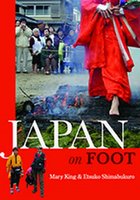
2001/2002
IT TOOK four days of traipsing through intense heat to reach Shuri City, where Etsuko was born and raised. The muggy heat took an incredible toll on us during the stretch from Motobu town to Etsuko’s hometown, but there was much to absorb and enjoy en route to the city where the Kings of Okinawa once resided. A habu snake show, as well as walking past U.S. military bases where planes flew so low we would actually duck in fear that they were about to land on us, were just a few of the roadside entertainments that kept us on our toes. Sweat dripped from every pore, soaking our clothes, and we found ourselves stopping to grab drinks from vending machines at virtually every fifteen-minute interval. Mama-chan simply laughed and shrugged as her daughter stepped over the threshold for the first time in 10 years. Etsuko’s mother, who I had previously met at one of her son’s weddings in Tokyo, backed off as I went to hug and kiss her on the cheek. “No, no, no!” she screamed, waving me off like I were a monster yet at the same time revealing she had a mouth full of jet-black teeth. It was my turn to be horrified. “Good God!” I screeched. I had never seen such deteriorated teeth. Etsuko laughed. “Mom’s rustled up an Okinawan speciality; squid ink soup,” she tittered, leading me into the kitchen to show off a pot full of what looked like burning coal and petroleum. A few hours later, we all sat around laughing and chatting with teeth and tongues as terrifying as those of the Hindu goddess Kali. Mama-chan regaled me with tales about shamanesses and clairvoyants, as well as her own experiences with studying palmistry. Apparently, she was a born natural, according to her teacher. “This line on my hand here, I’m told, is very unusual. It seems that I was [warrior leader] Tokugawa Ieyasu in a previous life,” she earnestly told me. I shivered at the prospect. I presented her my palm and she scrutinized it carefully. “You don’t have any problems to make a living,” she proffered, and then a few minutes later added, “Look, if you can’t sell your book, both of you can live with me in Okinawa.”Mama-chan went on to explain that she believes palmistry, as well as the utterings of shamanesses, to be largely a load of bunkum. “I’m not superstitious at all,” she insisted, but three days later when Etsuko and I were ready to depart for Miyako Island, she suddenly presented me with a bag of salt. I was stumped. Was this some kind of Okinawan ritual that Etsuko had forgotten to mention? “The salt is for protection,” Mama-chan told me, throwing another bag at her daughter. “Come back here before Festival of the Dead; it’s dangerous to be traveling when the dead are walking around,” she warned. We sailed for Miyako Island, where I hoped to meet with a man who has devoted twenty years of his life to digging up huge rocks in his garden, apparently for spiritual purposes. The Hiryu sailed into the island at the unearthly hour of 4 a.m., leaving the two of us with no choice but to sleep out in the streets until the island awoke and shifted into gear for life and work. We took a bleary-eyed breakfast at Mos Burger, in Hirara City, where I was tickled pink to spot a handwritten sign that announced, “We are sorry, but it will rain a lot over the next few days. We have recently performed our rain dance.” Mr. Sadakichi Shinjo was not in the best of spirits when we met him. He was annoyed because we had turned up five minutes early while the eighty-year-old was in the midst of his lunch. Returning to his rice and fish, the old chap left Etsuko and me to sit in a room that was adorned with hundreds of strange-looking, coral-like rocks that, since 1980, he has dug up from his garden. After his meal, Mr. Shinjo ordered us to explore his garden on our own, and so Etsuko and I found ourselves clambering through a mini-jungle of banana trees, palms and lichen-covered rocks, until we fell upon what appeared to be the lost city of the Incas. Rocks of every size imaginable had been placed in groups here and there, and I felt both an essence of sanctity and the hand of a great artist at work. The coral-like stones were truly magnificent, arranged artistically, and bearing prayers and proverbs. Mr. Shinjo, however, was not impressed to hear that I considered him an artist. It definitely set the interview off on a wrong footing. The scrawny man with bushy grey hair was used to having people treat him like a guru. Didn’t I know that people came to him, clasping hands together and bowing in worship, in the hope that he would bless them and pass on his super-human strength. “Even athletes have come asking me to give them strength,” he warned us. Perhaps he was disappointed that neither of us was seeking out his blessings; he obviously felt that we weren’t sufficiently in awe of him.
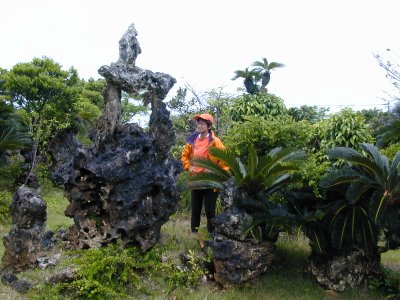
We had seen the huge holes in his garden, from where he digs his rocks, and I found it rather incredible that this small man could have lifted rocks?some of them weighing ten tons?alone. “Do you use some kind of digger,” I asked. Mr. Shinjo was now well and truly miffed by us. “This strength was given to me. It came after a dream when I was forty-seven. I was told that I needed to teach men about

His family had moved to the main Okinawan Island and left him to pursue his dream, but it seemed that he had become bitter. “My powers have now left me. I don’t have the strength anymore to dig for rocks. The rocks no longer speak to me and it’s no longer fun,” he snapped at us. Etsuko and I decided it was perhaps best to leave Mr. Shinjo to his own devices. He looked sad when we shook his hand and bid him well, but it was time for us to move on. Our next stop would be Hateruma Island, Japan’s southernmost inhabited point.











